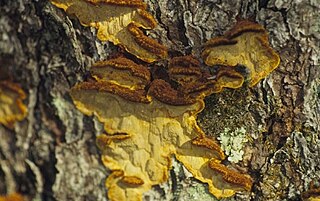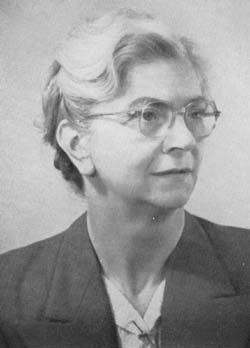Related Research Articles

Polypores are a group of fungi that form large fruiting bodies with pores or tubes on the underside. They are a morphological group of basidiomycetes-like gilled mushrooms and hydnoid fungi, and not all polypores are closely related to each other. Polypores are also called bracket fungi or shelf fungi, and they characteristically produce woody, shelf- or bracket-shaped or occasionally circular fruiting bodies that are called conks.

Dry rot is wood decay caused by one of several species of fungi that digest parts of the wood which give the wood strength and stiffness. It was previously used to describe any decay of cured wood in ships and buildings by a fungus which resulted in a darkly colored deteriorated and cracked condition.

In trees, heart rot is a fungal disease that causes the decay of wood at the center of the trunk and branches. Fungi enter the tree through wounds in the bark and decay the heartwood. The diseased heartwood softens, making trees structurally weaker and prone to breakage. Heart rot is a major factor in the economics of logging and the natural growth dynamic of many older forests. Heart rot is prevalent throughout the world affecting all hardwood trees and can be very difficult to prevent. A good indication of heart rot is the presence of mushrooms or fungus conks on the tree.

A wood-decay or xylophagous fungus is any species of fungus that digests moist wood, causing it to rot. Some species of wood-decay fungi attack dead wood, such as brown rot, and some, such as Armillaria, are parasitic and colonize living trees. Excessive moisture above the fibre saturation point in wood is required for fungal colonization and proliferation. In nature, this process causes the breakdown of complex molecules and leads to the return of nutrients to the soil. Wood-decay fungi consume wood in various ways; for example, some attack the carbohydrates in wood, and some others decay lignin. The rate of decay of wooden materials in various climates can be estimated by empirical models.

Mycelial cords are linear aggregations of parallel-oriented hyphae. The mature cords are composed of wide, empty vessel hyphae surrounded by narrower sheathing hyphae. Cords may look similar to plant roots, and also frequently have similar functions; hence they are also called rhizomorphs. As well as growing underground or on the surface of trees and other plants, some fungi make mycelial cords which hang in the air from vegetation.

Xylaria polymorpha, commonly known as dead man's fingers, is a saprobic fungus. It is a common inhabitant of forest and woodland areas, usually growing from the bases of rotting or injured tree stumps and decaying wood. It has also been known to colonize substrates like woody legume pods, petioles, and herbaceous stems. It is characterized by its elongated upright, clavate, or strap-like stromata poking up through the ground, much like fingers. The genus Xylaria contains about 100 species of cosmopolitan fungi. Polymorpha means "many forms". As its name suggests, it has a very variable but often club-shaped fruiting body (stroma) resembling burned wood.

Phellinus pini is a fungal plant pathogen that causes tree disease commonly known as "red ring rot" or "white speck". This disease, extremely common in the conifers of North America, decays tree trunks, rendering them useless for lumber. It is a rot of the heartwood. Signs of the fungus include shelf-shaped conks protruding from the trunks of trees. Spores produced on these conks are blown by the wind and go on to infect other trees. Formal management of this disease is limited, and the disease is controlled primarily by cultural practices. Red ring rot is an important forest disturbance agent and plays a key role in habitat formation for several forest animals.

Spalting is any form of wood coloration caused by fungi. Although primarily found in dead trees, spalting can also occur in living trees under stress. Although spalting can cause weight loss and strength loss in the wood, the unique coloration and patterns of spalted wood are sought by woodworkers.

Ascocoryne sarcoides is a species of fungus in the family Helotiaceae. The species name is derived from the Greek sarkodes (fleshy). Formerly known as Coryne sarcoides, its taxonomical history has been complicated by the fact that it may adopt both sexual and asexual forms. Colloquially known as jelly drops or the purple jellydisc, this common fungus appears as a gelatinous mass of pinkish or purple-colored discs. Distributed widely in North America, Europe and Asia, A. sarcoides is a saprobic fungus and grows in clusters on the trunks and branches of a variety of dead woods. Field studies suggest that colonization by A. sarcoides of the heartwood of black spruce confers some resistance to further infection by rot-causing fungi. A. sarcoides contains the antibiotic compound ascocorynin, shown in the laboratory to inhibit the growth of several Gram-positive bacteria.
Dry rot treatment refers to techniques used to eliminate dry rot fungus and alleviate the damage done by the fungus to human-built wooden structures.

Robert Lee Gilbertson was a distinguished American mycologist and educator. He was a faculty member at University of Arizona for 26 years until his retirement from teaching in 1995; he was a Professor Emeritus at U of A until his death on October 26, 2011 in Tucson, Arizona. 2011. He held concurrent positions as Plant Pathologist, Agricultural Experiment Station, University of Arizona (1967–95) for a project Research on wood-rotting fungi and other fungi associated with southwestern plants and was collaborator and consultant with Center for Forest Mycology Research, US Forest Service, Forest Products Laboratory, Madison, Wisconsin (1957–1981).

Extracellular enzymes or exoenzymes are synthesized inside the cell and then secreted outside the cell, where their function is to break down complex macromolecules into smaller units to be taken up by the cell for growth and assimilation. These enzymes degrade complex organic matter such as cellulose and hemicellulose into simple sugars that enzyme-producing organisms use as a source of carbon, energy, and nutrients. Grouped as hydrolases, lyases, oxidoreductases and transferases, these extracellular enzymes control soil enzyme activity through efficient degradation of biopolymers.
Coniochaeta hoffmannii, also known as Lecythophora hoffmannii, is an ascomycete fungus that grows commonly in soil. It has also been categorized as a soft-rot fungus capable of bringing the surface layer of timber into a state of decay, even when safeguarded with preservatives. Additionally, it has pathogenic properties, although it causes serious infection only in rare cases. A plant pathogen lacking a known sexual state, C. hoffmannii has been classified as a "dematiaceous fungus" despite its contradictory lack of pigmentation; both in vivo and in vitro, there is no correlation between its appearance and its classification.

Institute of Wood Science and Technology (IWST) is a Research institute situated in Bangalore in Karnataka. It works under the Indian Council of Forestry Research and Education (ICFRE) of the Ministry of Environment and Forests, Govt. of India. It is recognized to be a Centre of Excellence for Sandalwood Research and Wood Science

Mariya Yakovlevna Zerova, alternately Marija Jakovlevna Zerova, was a Ukrainian biologist and taxonomist known for her work in mycology.

Piling foundations support many historic structures such as canneries, wharves, and shore buildings. The old pilings present challenging problems during restoration as they age and are destroyed by organisms and decay. Replacing the foundation entirely is possible but expensive. Regularly inspecting and maintaining timber piles may extend the life of the foundation.

Phialophora fastigiata is a mitosporic, saprophytic fungus commonly found in soil, and on wood, and wood-pulp. This species was initially placed in the genus Cadophora but was later transferred to the genus Phialophora based on morphological and growth characteristics. In culture, P. fastigiata produces olive-brown, velvety colonies. The fungus is recognizable microscopically due to the presence of distinctive, funnel-shaped cuffs (collarettes) encircling the tips of phialides that bear slimy conidia. The fungus is often implicated in soft-rot wood decay due to its ability to degrade lignin, cellulose and pectin. It has also been reported to cause blue staining of wood and wood pulp.
Lynne Boddy is a Professor of Microbial Ecology at Cardiff University. She works on the ecology of wood decomposition, including synecology and autecology. She won the 2018 Learned Society of Wales Frances Hoggan Medal.

Lilian Edith Hawker was a British mycologist, known for her work on fungal physiology, particularly spore production. She was an expert on British truffles, and also published in the fields of plant physiology and plant pathology. She was also known for her contributions to education in mycology. Most of her career was spent at the botany department of the Imperial College of Science and Technology (1932–45) and the University of Bristol (1945–73), where she held the chair in mycology (1965–73) and was dean of the science faculty (1970–73). She served as president of the British Mycological Society, and was elected an honorary member of that society and of the Mycological Society of America. She published an introduction to fungi and two books on fungal physiology, of which Physiology of Fungi (1950) was among the first to survey the field, and also co-edited two microbiology textbooks.
N. Louise Glass is the Fred E. Dickinson Chair of Wood Science and Technology at the University of California, Berkeley. She specialises in plant and microbial biology, particularly fungal cell biology and genetics
References
- 1 2 3 4 5 6 7 8 9 10 11 12 Cowling, E. (1969). "Catherine Gross Duncan 1908–1968". Phytopathology. 59 (12): 1777. PMID 4907568.
- 1 2 3 4 Elsyn, W.E. (1969). "Catherine Gross Duncan (1908–1968)". Mycologia. 61 (1): 27–29. doi:10.1080/00275514.1969.12018698. JSTOR 3757342.
- 1 2 Ogilvie, M. B.; Harvey, J. D. (2000). The Biographical Dictionary of Women in science: Pioneering Lives from Ancient Times to the Mid-20th Century . New York: Routledge.
- 1 2 Duncan, G.C.; Deverall F.J. (1964). "Degradation of Wood Preservatives by Fungi". Applied Microbiology. 12 (1): 57–62. doi:10.1128/AEM.12.1.57-62.1964. PMC 1058065 . PMID 16349644.
- ↑ Duncan, G.C.; F.F. Lombard (1965). Fungi Associated with Principal Decays in Wood in the United States (Report). Washington, DC: U.S. FOREST SERVICE RESEARCH PAPER. WO-4.